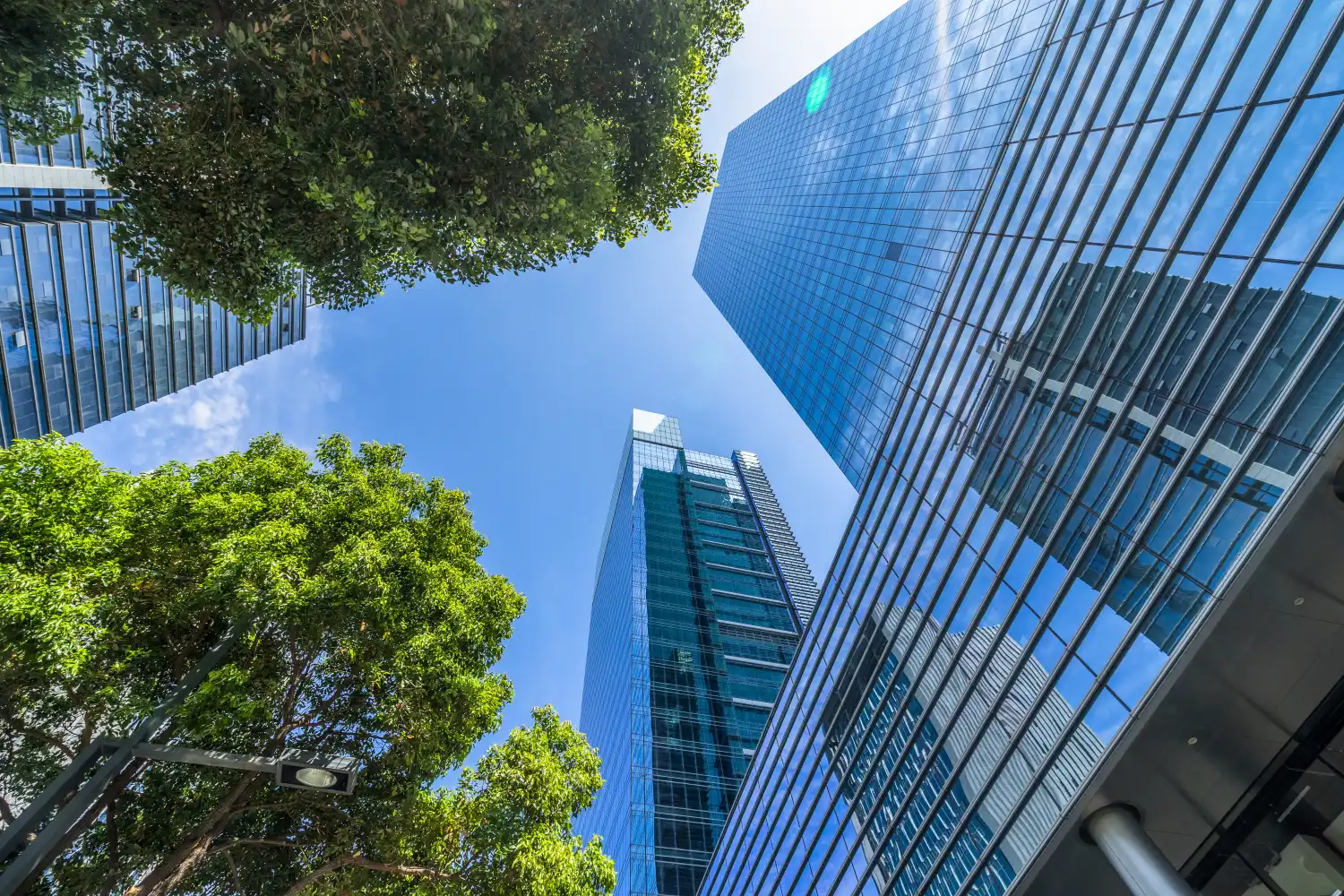Contributors
Related Articles
Stay Up To Date
Something has gone wrong, check that all fields have been filled in correctly. If you have adblock, disable it.
The form was sent successfully
After a period of doubt and retrenchment, China’s innovation economy is back in motion—and moving fast. From robotaxis to humanoid robotics, the country’s industrial and consumer landscape is transforming in real time. In this article, our team explores how policy developments, technology breakthroughs, and world-class execution are reshaping our investment lens on China.
Key Points
- Artificial intelligence (AI), automation, and electric vehicles are no longer future bets; they’re reshaping factories, supply chains, and consumer experiences right now.
- The government is implementing policy more assertively, aligning with private sector growth and setting the stage for more stable macroeconomic conditions.
- We have been increasing our exposure to China over the last year based on our focus on dominant businesses that have been defining secular trends in electrification, consumer products, services, and advanced manufacturing.
In 2022, we asked a question that felt nearly impossible to answer with confidence: Is China investable? The world’s second-largest economy was mired in uncertainty—battered by regulatory tightening, pandemic isolation, and escalating tensions with the West. Investor sentiment had cooled, headlines brimmed with doubt, and our approach grew cautious. China remained part of our opportunity set but was waning. We responded not by retreating but by narrowing our lens—focusing on bottom-up fundamentals and maintaining a decisive underweight in our Emerging Markets Growth strategy.
In August 2025, China feels different. We had lunch delivered by drone in Shenzhen’s city center, zipped across Beijing suburbs in silent robotaxis, and toured factories where humanoid robots work shifts beside their human counterparts. These aren’t experiments. They’re evidence. The economy may still be finding its footing, but innovation, which has been gaining momentum, is now sprinting ahead. The clarity of policy signals, the scale of entrepreneurial ambition, and the pace of technological deployment are unmistakable. After extensive research trips and dozens of company visits, we’re no longer asking whether China is investable—we’re examining how to invest more intelligently.
What emerged wasn’t a single data point but a shift in temperature. China isn’t waiting to catch up. It’s building at speed and shaping the rules of the game while doing it.
Reframing Our Perspective
Looking back, our first post-COVID-19 trip in 2023 painted a picture of uncertainty. Economic growth was sluggish; unemployment was elevated; and policy communication was ambiguous. Regulatory crackdowns—particularly in the internet and technology sectors during 2021 and 2022—were still unsettling investors. Geopolitical friction, especially with the United States, added further strain. We saw promise in areas such as renewable energy and industrial automation, but we viewed those opportunities as narrow and conditional. Our strategy was to remain cautious and selective. Much has shifted since those assessments.
Today, we maintain our realism, but we’re also acknowledging the speed of change. On-the-ground signals—from autonomous mobility to industrial robotics—point to an economy recalibrating, not retracting.
Examining Stability in China’s Policy and Economy
China’s macroeconomic evolution since 2024 reflects a careful balancing act between maintaining stability and enabling transformation, as the government has ramped up its response with a series of measures designed to shore up growth without reigniting systemic risks. Most notably, a clear policy bias toward targeted stimulus focused on infrastructure, green technology, and strategic consumption support has emerged.
The near-term economic outlook hinges on how effectively these policies are executed. While large-scale monetary easing has been rolled out, fiscal policies, particularly those targeting long-term goals, are still pending further calibration. Local governments are issuing long-duration bonds to finance public investments in urban renewal, transportation, and healthcare. At the national level, tax credits and cash incentives aim to boost household consumption and corporate innovation.
This more robust fiscal architecture is paired with a growing acknowledgment of structural reform priorities. These include broadening the tax base, reducing regional inequality, expanding the social safety net, and refining the legal framework to protect private enterprises. While progress is incremental, the signaling from senior leadership is more pragmatic and investor-aware than it had been in recent years.
After extensive research trips and dozens of company visits, we’re no longer asking whether China is investable—we’re examining how to invest more intelligently.
Importantly, China’s economic recalibration is happening against a dynamic global backdrop. Trade tensions with the United States, while still present, appear to be stabilizing. Scenarios projecting moderate tariffs are now being incorporated into baseline forecasts. Investors are no longer frozen by fear of decoupling but instead are recalibrating around the new contours of geopolitical friction. The evidence of recent years supports the view that China’s technological progress is mostly driven by internal factors that are well diffused across sectors. Robust infrastructure and manufacturing capabilities alongside abundant talent resources and government support have helped China to achieve a global-leading position in key industries of the future despite worsening geopolitics and a “tech war” with the world’s most advanced economy.
In late 2024, China’s policymakers began demonstrating a clearer resolve. Fiscal policy targeted infrastructure, supporting the property sector, alleviating the debt burden of local governments, boosting consumer spending, and restoring confidence in capital markets. New initiatives aimed to support small businesses and shore up consumer confidence. Rhetoric gave way to action, such as a “cash-for-clunkers” program to support the sale of automobiles and consumer electronics products. More importantly for investors, the tone of policy toward entrepreneurs, innovators, and the private sector became more constructive, culminating in the symbolic public meeting of President Xi with China’s leading tech entrepreneurs in February 2025.
Though challenges remain, structural reform is slow, and some local governments remain cautious because of strained finances—the overall economic direction feels more coordinated. Tax reform, welfare expansion, and industrial subsidies are increasingly aligned with long-term national goals. Tariff tensions with the United States appear to be entering a managed détente. All of this creates space for domestic growth and private sector ambition.
Tracking the Pace of Innovation Across Industries
Innovation in China has accelerated into a full sprint; it’s not confined to elite labs or glossy corporate decks. Across logistics centers, industrial parks, and research hubs, the deployment of automation, AI, and smart systems is becoming routine. What once felt like speculative tech now appears in public spaces and supply chains alike.
At the recent JPMorgan and UBS China summits, the mood was decidedly forward-leaning. Investor participation surged, not out of hope but out of recognition that China’s scale, talent, and manufacturing infrastructure are unlocking commercialization at breathtaking speed. One-third of global goods are still made in China, and the country installs more industrial robots than the rest of the world combined. Add in ultra-dense supply ecosystems—such as the 157 firms supporting iPhone assembly in Shenzhen—and the flywheel of iterative improvement becomes self-propelling.
Chinese robotics players such as Engine AI are prototyping humanoids that move fluidly through city plazas and interact with tourists using real-time large language models. These are not isolated experiments. In Shenzhen, humanoid robots are already patrolling pedestrian zones, applying face detection to assist with missing persons and public safety. Meanwhile, companies like Dobot are scaling up intelligent cobots that can be trained by end-users in under two weeks—enabling automation in industries that were previously out of reach due to cost and complexity.
Cost curves are bending in real time. AI is becoming embedded not just in planning and supply chain optimization but also in the physical mechanics of manufacturing and delivery. In sectors such as electric vehicles (EVs) and battery production, China’s innovation is setting global benchmarks—not catching up but leading. As hardware matures, we are beginning to see an inflection point where Chinese firms are not only building the future—they are shaping how it will be manufactured and standardized.
Observing Changes in Consumer Sentiment and Spending
While innovation grabs headlines, it’s consumer resilience that anchors the recovery. In cities across China, we see that the nature of spending has shifted. Consumers are more value-conscious and discerning yet still aspirational and experience-oriented. This combination creates a fertile ground for consumer brands that can deliver newness and emotional value at a compelling price.
Younger generations, in particular, are leading the charge. Born into a mobile-first, choice-rich economy, they navigate easily between traditional retail and livestream shopping. They prioritize wellness, identity, and tech-savvy experiences over status. In contrast, older cohorts remain more measured in their spending, shaped by wealth effects tied to the property and equity markets.
Policy continues to play an important role. First-tier cities have been negatively affected by wealth effects from the property market and equity investment, as well as the increased availability of jobs. As a result, we have seen consumers develop more cautious spending habits. This caution has particularly affected mass markets, but niche areas, such as beauty, gaming, and entertainment, continue to grow. On the other hand, consumers in lower-tier cities have benefited from more affordable housing prices, reduced work pressure, and infrastructure improvements.
Experience-led consumption is evolving fast. In China, leisure travel and live entertainment are undergoing a powerful resurgence, fueled by a post-pandemic rebound in discretionary spending and a generational shift toward lifestyle-centric values. In 2024, domestic tourism volumes surged past pre-pandemic levels, with more than 295 million trips recorded during the May Golden Week alone—a 30 percent increase from the prior year.1 The rising middle class, now over 500 million strong, is driving demand for novel travel experiences, including the “special forces” tourism trend in which young people take high-intensity, budget-friendly trips curated by influencers.2 While outbound travel has been slower to return, countries with visa-waiver programs for Chinese nationals are seeing growing traffic.3 At the same time, concert attendance is booming, with top acts like Jay Chou selling out shows in major Chinese cities. In the first three quarters of 2023, a total of 342,400 commercial performances (concerts and music festivals of all scales) were staged nationwide, generating RMB 31.54 billion in box-office receipts—a 453.7 percent increase versus the same period in 2019.4
These trends are amplified by the rise of Gen Z consumer culture, a surge in “revenge spending,” and public sector investment in event infrastructure.5

At the heart of this shift is a redefinition of consumption. In Shanghai, Adidas has created a running mecca—a 27-kilometer riverside route on the city’s West Bund. Once an industrial zone, the area has been transformed into a vibrant public space that houses Adidas’ Runbase store, which lends performance sneakers to joggers. It’s a small but telling sign of a retail landscape that prizes engagement over transaction. Across China, restaurants, coffee chains, and wellness studios now compete not only on price but also on ambiance, storytelling, and personalization.
Meituan has redefined the delivery speed of ecommerce by offering instant shopping. We visited its dark stores, or lightening warehouses, which are online only fulfillment centers that stock and deliver thousands of products to customers within the hour. These are located conveniently close to communities they serve.
We witnessed the dispatching of orders and interviewed riders to better understand Meituan’s unit economics. The company owns the largest and most agile delivery network in China and commands a nearly 70 percent share by gross merchandise value in food delivery orders over 30 RMB (1 RMB=0.14 USD), despite intense competition and aggressive subsidies from ecommerce giants. Its hybrid model blends online convenience with offline infrastructure, allowing brands to open InstaMart-style storefronts that reduce operating costs while increasing turnover and delivery efficiency.6
This evolution of ecommerce is not just logistical, it’s experiential. Platforms, such as Meituan, are creating a consumption model built around immediacy, reliability, and lifestyle integration. This fusion of logistics and lifestyle is giving rise to new consumer archetypes. What appears to matter to people now is not just what they buy but how their purchases fit into a more convenient and experiential life.
For many investors, the implications are significant. Beneficiaries range from online travel agencies to entertainment platforms, transport, retail, and hospitality providers servicing China’s most active leisure corridors. Increasingly, companies that enable or enhance these experiences, whether through payments, logistics, digital access, or security, are becoming critical enablers of the country’s consumption upgrade and could offer compelling long-term investment potential.
Realigning Our Portfolio to Structural Trends
We’re not investing in hopes of a macroeconomic rebound. We’re aiming to position around secular forces reshaping China’s economic fabric. These aren’t passing themes, we believe they’re deep, systemic shifts with long investment runways. In our view, the most compelling are:
- Electrification and clean energy continue to dominate capital formation and policy focus. EVs, battery innovation, and grid optimization are increasingly intertwined. China’s capacity to lead in this domain is supported not just by scale but also by integration—from materials to manufacturing to mobility solutions.
- Intelligent automation and robotics are no longer aspirational. Whether in industrial zones or consumer-facing logistics, Chinese firms are embedding AI across functions. The goal is not just efficiency but global relevance, and in many cases, global leadership.
- Consumer wellness and digital lifestyle are emerging as a powerful axis of growth. We see demand rising for fitness, personal expression, and experiential services. These trends cut across income segments and city tiers, creating opportunities in retail, health, and technology.
- Service sector formalization, from education and healthcare to urban transit and fintech, remains a structural priority. It reflects a long-standing goal to rebalance growth toward consumption and improve social welfare. We’re increasingly focused on companies that align with this shift.
These secular trends shape how we aim to screen for quality, durability, and upside. They also inform how we engage with companies in understanding issues such as product pipelines or capacity expansion plans.

We have been increasing our exposure to China and in doing so to build high-conviction positions in companies that don’t just ride trends—they define them.
- Xiaomi, for example, surprised us with its highly competitive EV offering and strong manufacturing capability. Its SU7 already outsells the Model 3 and its follow-up SUV garnered almost 300,000 orders in an hour.7 We toured its nearly hands-free production line, which is on track to bring its EV business to breakeven within just 20 months of first car launch. Through this achievement, Xiaomi has successfully integrated its smartphone, Internet of Things, and EV into a comprehensive product ecosystem.
- BYD is a masterclass in end-to-end manufacturing. From batteries to semiconductors to final assembly, it controls its value chain. Dealer feedback from Brazil to Thailand confirms that it’s exporting profitability, not just product.
- Contemporary Amperex Technology (CATL) dominates the EV battery market and is the leader in terms of market share, which continues to expand thanks to strong demand in Europe. Its unit profitability is multiple times that of its competitors, demonstrating its advantage in scale, manufacturing, and technological capabilities, as well as its grasp of its supply chain through vertical integration. Meanwhile, it is redefining the economics of energy storage. Innovations in heat management and production throughput are slashing costs at scale. Offtake agreements now cover 85 percent of capacity through 2027.
- Meituan, as discussed above, operates a platform that connects three sides of the network—consumers, merchants, and delivery crew—with superior algorithms. It leverages its instant fulfillment capabilities to improve instant ecommerce, achieving an average 30-minute delivery speed. It also improves efficiencies and reduces operating costs through innovative supply formats, such as InstaMart, that are enabled by data insights, technological innovations, and improved operations. At Meituan’s logistics hub, we saw real-time rider assignments mapped across neighborhoods. Despite new entrants and aggressive subsidies, the company still owns 70 percent of food delivery value.
- Anta Sports Products is riding a wave of wellness. Its athletic and outdoor brands have been pulling ahead, thanks to digital supply chain upgrades and disciplined brand management.
- Foshan Haitian Flavoring has turned automation into artistry. Its soy sauce factory can switch between 120 stock-keeping units (SKUs) without pausing production—and now licenses its factory model to regional partners.
These aren’t just good businesses. We believe they’re the kind of companies that help define a market.
Why We’re Rebuilding Our China Exposure
China advances through zigzag inflection points—policy experiments, global headwinds, and local reforms. Yet the narrative unveiled on our recent trip is more coherent than any since the pandemic began.
Risks remain—property sector indebtedness, demographic headwinds, and geopolitical friction—but the choice facing investors is not whether to participate but how to position with discipline. It requires identifying and allocating to the businesses best aligned with long-term structural currents.
By steadily increasing our exposure to positions in policy-aligned innovators, we aim to capture the compounding benefits of China’s disciplined policy framework, self-reinforcing secular trends, and sophisticated entrepreneurial execution. The quiet hum of electric rides, the confidence of driverless commutes, and the precision of near-instant deliveries are more than anecdotes—they are real-time data points guiding our path forward. Our mission remains to stay at the frontier, distill unfiltered insights into rigorous allocations, and deliver enduring value for our clients.
1 Ministry of Culture and Tourism of the People’s Republic of China, Golden Week Tourism Data, May 2024.
2 McKinsey & Company, “The Chinese Consumer Report 2024.”
4 https://www.theworldofchinese.com/2023/12/the-stories-that-shaped-chinas-music-industry-in-2023/
6 Meituan’s InstaMart is an instant retail service within Meituan’s broader on-demand delivery business.
Disclosures:
As of August 21, 2025, Anta Sports Products, BYD, Contemporary Amperex Technology, Foshan Haitian Flavoring, Meituan, and Xiaomi were held across Sands Capital strategies and were referenced because our research team visited them in their most recent trips. Other companies mentioned are not held in Sands Capital strategies and were cited to illustrate the views expressed in the commentary.
The views expressed are the opinion of Sands Capital and are not intended as a forecast, a guarantee of future results, investment recommendations, or an offer to buy or sell any securities. The views expressed were current as of the date indicated and are subject to change.
This material may contain forward-looking statements, which are subject to uncertainty and contingencies outside of Sands Capital’s control. Readers should not place undue reliance upon these forward-looking statements. There is no guarantee that Sands Capital will meet its stated goals. Past performance is not indicative of future results.
All investments are subject to market risk, including the possible loss of principal. Recent tariff announcements may add to this risk, creating additional economic uncertainty and potentially affecting the value of certain investments. Tariffs can impact various sectors differently, leading to changes in market dynamics and investment performance. You should consider these factors when making investment decisions. International investments can be riskier than US investments due to the adverse effects of currency exchange rates, differences in market structure and liquidity, as well as specific country, regional and economic developments. Investments in emerging markets are subject to abrupt and severe price declines. The economic and political structures of developing nations, in most cases, do not compare favorably with the US or other developed countries in terms of wealth and stability, and their financial markets often lack liquidity. Because of this concentration in rapidly developing economies in a limited geographic area, the strategy involves a high degree of risk. In addition, the strategy is concentrated in a limited number of holdings. As a result, poor performance by a single large holding of the strategy would adversely affect its performance more than if the strategy were invested in a larger number of companies. The strategy’s growth investing style may become out of favor, which may result in periods of underperformance. The strategy may experience losses as it is subject to equity securities risk, market and issuer risk, selection risk, growth style risk, concentration risk, currency exchange risk, foreign company risk, derivatives risk and other economic risks that may influence the returns of this strategy.
The specific securities identified and described do not represent all of the securities purchased, sold, or recommended for advisory clients. There is no assurance that any securities discussed will remain in the portfolio or that securities sold have not been repurchased. You should not assume that any investment is or will be profitable.
Differences in account size, timing of transactions, and market conditions prevailing at the time of investment may lead to different results, and clients may lose money. A company’s fundamentals or earnings growth is no guarantee that its share price will increase. Forward earnings projections are not predictors of stock price or investment performance, and do not represent past performance. Characteristics, sector (and regional, country, and industry, where applicable) exposure, and holdings information are subject to change and should not be considered as recommendations.
Charts and graphs are presented for illustrative purposes only.
References to “we,” “us,” “our,” and “Sands Capital” refer collectively to Sands Capital Management, LLC, which provides investment advisory services with respect to Sands Capital’s public market investment strategies, and Sands Capital Alternatives, LLC, which provides investment advisory services with respect to Sands Capital’s private market investment strategies, which are available only to qualified investors. As the context requires, the term “Sands Capital” may refer to such entities individually or collectively. As of October 1, 2021, the firm was redefined to be the combination of Sands Capital Management, LLC, and Sands Capital Alternatives, LLC. The two investment advisers are combined to be one firm and are doing business as Sands Capital. Sands Capital operates as a distinct business organization, retains discretion over the assets between the two registered investment advisers, and has autonomy over the total investment decision-making process.
Information contained herein may be based on, or derived from, information provided by third parties. The accuracy of such information has not been independently verified and cannot be guaranteed. The information in this document speaks as of the date of this document or such earlier date as set out herein or as the context may require and may be subject to updating, completion, revision, and amendment. There will be no obligation to update any of the information or correct any inaccuracies contained herein.
Notice for non-US Investors.
















